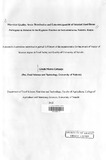| dc.description.abstract | Street foods playa significant role in feeding the urban population with cheap, accessible and nutritious foods. Most street foods vendors are not trained on food hygiene and safety and operate in an unregulated business. Street food can lead to food poisoning and consequent food
borne illnesses. Although studies on the safety of street foods have been carried out in most developing countries, not much has been done in Nairobi city in Kenya. This study was carried out to investigate microbial safety and hygiene practices in the vending of street foods in Nairobi city, Kenya. A total of 56 samples classified using seven modified FAO food groups from 29 vending stalls were evaluated. Standard microbiological methods were used for isolation, enumeration and identification of bacteria.
No salmonella was detected per 25g in all food samples. Escherichia coli was qualitatively isolated in 3 food samples including mixed dish from Lunga lunga road and vegetables in Lunga lunga and Nanyuki roads. Vegetables from all locations had coliform levels (4.48 mean 10gJO cfu/g) that did not meet the quality standards (4.00 10gJO cfu/g) of ready to eat food. The coliform counts (Iogu, cfu/g) were 3.84 in meats, 2.72 in mixed dishes;, 2.33 in legumes, 2.42 in starchy roots, 2.33 in cereals and below detection limits in beverages. Enterococci were detected (logm cfu/g) in vegetables at 2.5, 2.40 in meats, , 2.04 in legumes, 2.44 in starchy roots 2.66 in cereals but below detection limit in mixed dishes and beverages. Staphylococcus aureus were detected (logJO cfu/g) in vegetables at 4.03, 3.45 in meats, 3.37 in legumes, 3.32 in mixed dishes and 3.27 in cereals.
None were detected in starchy roots and beverages. Vegetable foods contained high microbial counts mostly greater than 4.0 10gJO cfu/g) in all the food consumption food groups including Coliforms at 4.48 10gJO cfu/g Staphylococcus aureus at 4.03 10gJO cfu/g, total Enterococci at 2.50 10gJO cfu/g. Vegetables however had acceptable total count of 4.71 10gJO cfu/g against the 6.00 10gJO cfu/g standard limits. Rep peR revealed that isolates from each of Enterobacter aerogenes, Enterococci species and Staphylococcus aureus isolated from street foods of Industrial area in Nairobi and were related strains. The presence of staphylococcal enterotoxins (se); sea, seb, sec, sed, see, seg, sei & sej was also evaluated in Staphylococcus aureus. None of the isolates from street food possessed genes coding for production of the staphylococcal enterotoxins.
It was noted that 94% of vending sites were exposed to potential contaminants. A total of76% (22/29) of vendors did not have food handlers' medical certificate. Eighty eight per cent of the sites were clean. A total of 79% of the stalls were constructed using polythene bags. A total of 66% (19129) vendors did not have protective clothing, 79% (23/29) vendors had no training on food hygiene, and 87% of vendors used polythene bags for packaging take away rations. However, 79% of the vendors reported no customer complaints concerning food safety. A total of 69% of vendors dump their wastes into Nairobi city council waste bins, while 79% (23/29) use the Nairobi city council sanitary facilities.
It can be concluded that street foods evaluated from food groups consisting of cereals, legumes, starchy roots, beverages and some with meat were considered safe for human consumption as per the data. Vegetables had unacceptable contamination levels of coliforms and Staphylococcus aureus, while meat (fish) from Nanyuki road had unacceptable levels of coliforms. The relatedness of isolates from this study implies possibility of a common source of contamination such as contaminated processing water, or cross contamination of raw materials and cooked food by equipment or vendors. The occurrence of indicator microorganisms in most of the foods indicated a need for improvement in the processing environment hygiene of street food. There is need to provide water, sanitary facilities and waste collection services, training programs and educating the street food vendors. | en_US |

